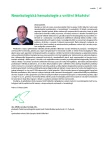Autoimmune hemolytic anemia
Authors:
Jaroslav Čermák 1,2; Martin Písačka 1,2
Authors‘ workplace:
Ústav klinické a experimentální hematologie 1. LF UK, Praha
1; Ústav hematologie a krevní transfuze, Praha
2
Published in:
Vnitř Lék 2018; 64(5): 514-519
Category:
Overview
Autoimmune hemolytic anemia (AIHA) is caused by auto-antibodies directed against self red blood cell (RBC) surface antigens. A consequence may be an intravascular hemolysis mediated by activated complement or extravascular hemolysis caused by destruction of complex of RBC with autoantibody in spleen and liver. The basic classification subdivides AIHA in primary/idiopathic and secondary with known underlying disease. A classification according to the thermal range of antibody recognizes warm AIHA, cold aglutinin disease (CAD), mixed AIHA and paroxysmal cold hemoglobinuria. Pathogenesis of AIHA consists of a defective antigen presentation to immunocompetent cells, insufficient process of T-lymphocyte tolerance to autoantigens and induction of autoantibody production by B-lymphocytes. For the diagnosis of AIHA are essential direct and indirect antiglobulin tests. The first-line therapy for warm AIHA is still administration of corticosteroids. For non-responding patients, second-line treatment includes rituximab or splenectomy. Combination of other immunosuppressive drugs represents a third-line treatment for resistant/relapsing patients. Rituximab is a treatment of choice for patients with CAD.
Key words:
anemia hemolytic – autoimmunity – corticosteroids – diagnosis – pathogenesis – rituximab – splenectomy – treatment
Sources
- Marcus N, Attas D, Tamary H. Autoimmune hemolytic anemia: current understanding of pathophysiology. Hematology Education: educational program of the annual congress of EHA 2014; 8: 321–328.
- Hawiger D, Inaba K, Dorsett Y et al. Dendritic cells induce peripheral T cell unresponsiveness under steady state conditions in vivo. J Exp Med 2001; 194(6): 769–779.
- Vidarsson G. Factors contributing to the pathogenesis of IgG-mediated autoimmune disease. Hematology Education: educational program of the annual congress of EHA 2015; 9: 249–256.
- Noack M, Miossec P. Th17 and regulatory T cell balance in autoimmune and inflammatory diseases. Autoimmun Rev 2014; 13(6): 668–677. Dostupné z DOI: <http://dx.doi.org/10.1016/j.autrev.2013.12.004>.
- Kurien BT, Scofield RH. Autoimmunity and oxidatively modified autoantigens. Autoimmun Rev 2008; 7(7): 567–573. Dostupné z DOI: <http://dx.doi.org/10.1016/j.autrev.2008.04.019>.
- Zanella A, Barcellini W. Treatment of autoimmune hemolytic anemias. Haematologica 2014; 99(10): 1547–1554. Dostupné z DOI: <http://dx.doi.org/10.3324/haematol.2014.114561>.
- Lechner K, Jager U. How I treat autoimmune hemolytic anemias in adults. Blood 2010; 116(11): 1831–1838. Dostupné z DOI: <http://dx.doi.org/10.1182/blood-2010–03–259325>.
- Barcellini W, Zanella A. Rituximab therapy for autoimmune haematological diseases. Eur J Intern Med 2011; 22(3): 220–229. Dostupné z DOI: <http://dx.doi.org/10.1016/j.ejim.2010.12.016>.
- Barcellini W, Zaja F, Zaninoni A et al. Low-dose rituximab in adult patients with idiopathic autoimmune hemolytic anemia: clinical efficacy and biological studies. Blood 2012; 119(16): 3691–3697. Dostupné z DOI: <http://dx.doi.org/10.1182/blood-2011–06–363556>.
- Berentsen S, Ulvestad E, Gjertsen BT et al. Rituximab for primary chronic cold agglutinin disease: a prospective study of 37 courses of therapy in 27 patients. Blood 2004; 103(8): 2925–2928. Dostupné z DOI: <http://dx.doi.org/10.1182/blood-2003–10–3597>.
- Berentsen S, Randen U, Vagan AM et al. High response rate and durable remissions following fludarabine and rituximab combination therapy for chronic cold agglutinin disease. Blood 2010; 116(17): 3180–3184. Dostupné z DOI: <http://dx.doi.org/10.1182/blood-2010–06–288647>.
Labels
Diabetology Endocrinology Internal medicineArticle was published in
Internal Medicine

2018 Issue 5
Most read in this issue
- Autoimmune hemolytic anemia
- Differential diagnosis of anemia
- Congenital and acquired bleeding disorders
- Hemoglobinopathies
